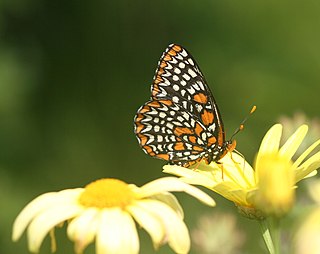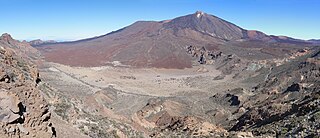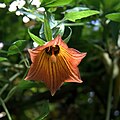
A pollinator is an animal that moves pollen from the male anther of a flower to the female stigma of a flower. This helps to bring about fertilization of the ovules in the flower by the male gametes from the pollen grains.

Arbutus is a genus of 12 accepted species of flowering plants in the family Ericaceae, native to warm temperate regions of the Mediterranean, western Europe, the Canary Islands and North America. The name Arbutus was taken from Latin, where it referred to Arbutus unedo.

Lotus berthelotii is a flowering plant endemic to the Canary Islands of Spain, in the genus Lotus of the pea family Fabaceae. Among its common names are lotus vine flower, parrot beak, pelican beak, and coral gem. This plant is widely cultivated but is either extinct in the wild or persists as a few individuals. In 1884 it was already classed as "exceedingly rare" and plant collection probably hastened its decline.

Zoophily, or zoogamy, is a form of pollination whereby pollen is transferred by animals, usually by invertebrates but in some cases vertebrates, particularly birds and bats, but also by other animals. Zoophilous species frequently have evolved mechanisms to make themselves more appealing to the particular type of pollinator, e.g. brightly colored or scented flowers, nectar, and appealing shapes and patterns. These plant-animal relationships are often mutually beneficial because of the food source provided in exchange for pollination.

Phoenix canariensis is a species of flowering plant in the palm family Arecaceae, native to the Canary Islands. It is a relative of Phoenix dactylifera, the true date palm. It is the natural symbol of the Canary Islands, together with the canary Serinus canaria. Mature P. canariensis are often used in ornamental landscaping and are collected and transplanted to their new planting location. A Canary Island date palm with 10 m (30 ft) of trunk is approximately 60 years of age.

Nectar is a sugar-rich liquid produced by plants in glands called nectaries or nectarines, either within the flowers with which it attracts pollinating animals, or by extrafloral nectaries, which provide a nutrient source to animal mutualists, which in turn provide herbivore protection. Common nectar-consuming pollinators include mosquitoes, hoverflies, wasps, bees, butterflies and moths, hummingbirds, honeyeaters and bats. Nectar plays a crucial role in the foraging economics and evolution of nectar-eating species; for example, nectar foraging behavior is largely responsible for the divergent evolution of the African honey bee, A. m. scutellata and the western honey bee.

Trochetia is a genus of flowering plants from the family Malvaceae. They are endemic to the Mascarene Islands.

Ornithophily or bird pollination is the pollination of flowering plants by birds. This sometimes coevolutionary association is derived from insect pollination (entomophily) and is particularly well developed in some parts of the world, especially in the tropics, Southern Africa, and on some island chains. The association involves several distinctive plant adaptations forming a "pollination syndrome". The plants typically have colourful, often red, flowers with long tubular structures holding ample nectar and orientations of the stamen and stigma that ensure contact with the pollinator. Birds involved in ornithophily tend to be specialist nectarivores with brushy tongues and long bills, that are either capable of hovering flight or light enough to perch on the flower structures.

Nesocodon is a monotypic genus of flowering plants within the family Campanulaceae. The sole species is Nesocodon mauritianus, formerly known as Wahlenbergia mauritiana, which is endemic to the island of Mauritius.

Pollination syndromes are suites of flower traits that have evolved in response to natural selection imposed by different pollen vectors, which can be abiotic or biotic, such as birds, bees, flies, and so forth through a process called pollinator-mediated selection. These traits include flower shape, size, colour, odour, reward type and amount, nectar composition, timing of flowering, etc. For example, tubular red flowers with copious nectar often attract birds; foul smelling flowers attract carrion flies or beetles, etc.

Isoplexis is a section of four species of flowering plants within the genus Digitalis in the plantain family Plantaginaceae. The species of section Isoplexis differ from other plants in the genus Digitalis in that their monosymmetric flowers have a distinctive large upper lip rather than large lower lip and the species are endemic to the Canary Islands and Madeira.

Malva phoenicea, often still known under the synonyms Lavatera phoenicea and Navaea phoenicea, is a large shrub of the family Malvaceae and tribe Malveae, endemic to the island of Tenerife in the Canary Islands.

Teide National Park is a national park located in Tenerife, Canary Islands, Spain.

The Micronesian myzomela is a species of bird in the honeyeater family Meliphagidae. The species forms a superspecies with a number of related and similar looking island and mainland myzomelas across the Pacific and Australasia. It in turn is composed of seven insular subspecies.

Ilex canariensis, the small-leaved holly, is an endemic species of holly native to Macaronesian islands. It is a species of plant in the family Aquifoliaceae. It is found in the Macaronesian islands of Madeira (Portugal) and Canary Islands (Spain).

Echium pininana, commonly known as the tree echium, pine echium, giant viper's-bugloss, or tower of jewels, is a species of flowering plant in the borage family Boraginaceae. It is endemic to the Canary Islands, where it is restricted to the island of La Palma. Echium pininana is an endangered species, and is listed in Appendix I to, and is therefore protected under, the Convention on the Conservation of European Wildlife and Natural Habitats. The specific epithet pininana is Latin for "small pine", though E. pininana is neither closely related to the pine, nor does it resemble that plant.

The La Palma chaffinch, also known as the Palman chaffinch or, locally in Spanish as the pinzón palmero or pinzón hembra, is a small passerine bird in the finch family Fringillidae. It is a subspecies of the common chaffinch that is endemic to La Palma in the Canary Islands, a Spanish archipelago that forms part of Macaronesia in the North Atlantic Ocean.

Hedera canariensis, the Canary Island ivy, Canary ivy or Madeira ivy, is a species of ivy, native to the Canary Islands and possibly the Atlantic coast of northern Africa.

Canarina canariensis is a species of flowering plant in the bellflower family Campanulaceae, commonly known as the Canary Island bellflower, and known locally as bicácaro.

Digitalis canariensis is a member of the genus Digitalis.





















